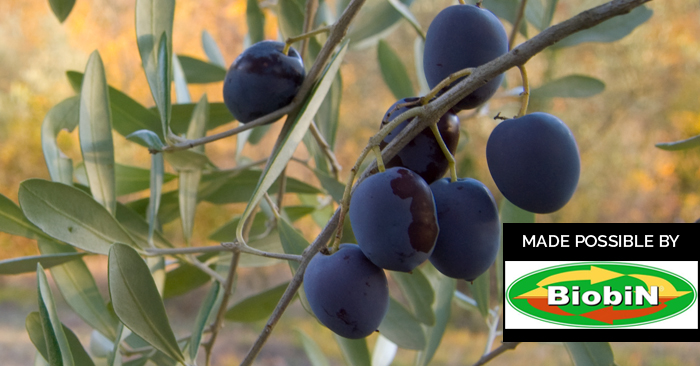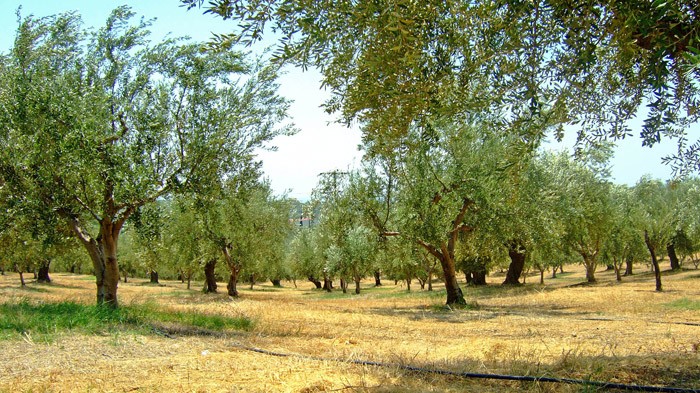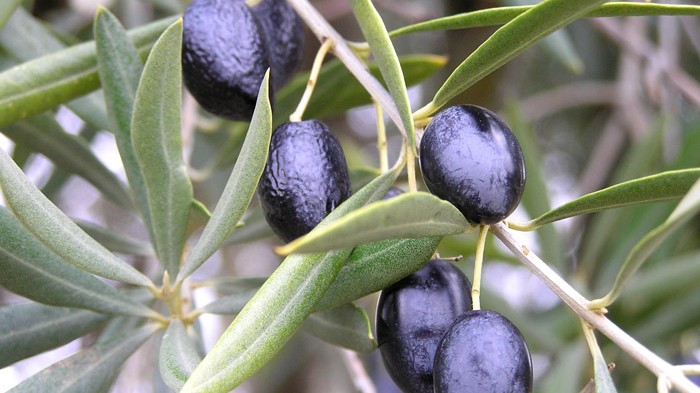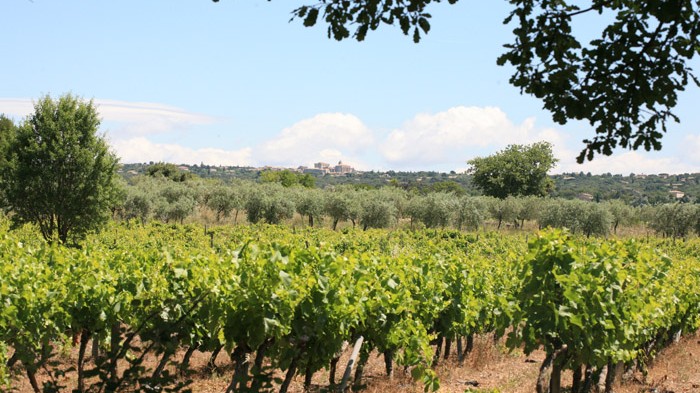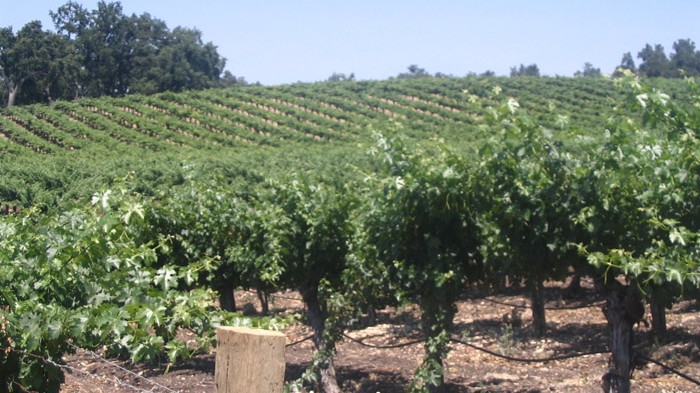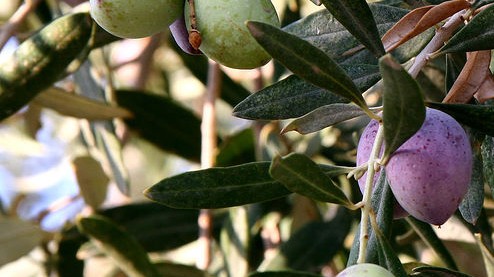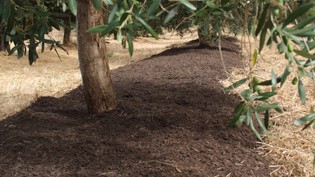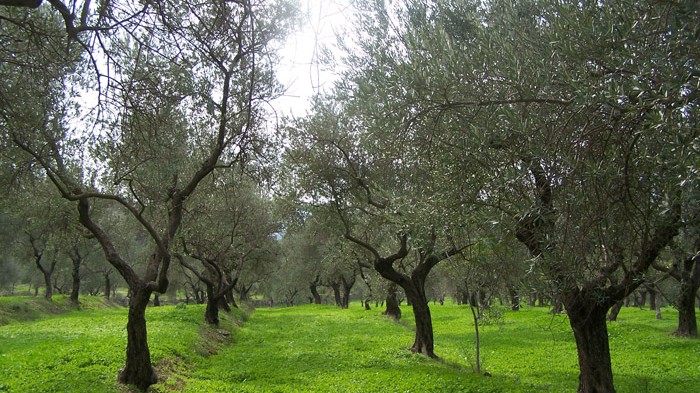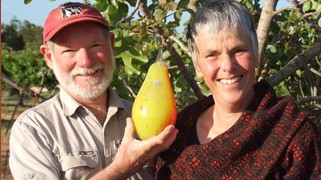TRANSCRIPT
The Food Forest – Soil and Olives
Q: Can you tell me a bit about the Food Forest and your olive orchard especially?
Graham Brookman: The Food Forest is a small farm, of about twenty hectares, and of that about seven hectares are irrigated, which is important because we have an annual rainfall of only about forty-four hundred mills (millilitres). We have about one hundred and sixty different varieties of food that we produce, and in addition to the raw foods, we do a lot of value adding; so we would not only produce grapes, but the wine from the grapes, and the vinegar from the wine, and so on. So we tend to have a value-adding stream, which then creates its own by-products, and those by-products go back into the input of the system to keep it going. So we need the least possible non-renewable inputs from the outside.
So, olives are a particularly interesting crop in our environment. They’re very sensitive to the amount of rain that you get, and if they don’t get enough water they will sulk and they won’t give you a crop. And if they get adequate water, then they’ll feel really good and generous and give you good crop. So, we’re sitting on the knife-edge with a crop like olives, and the management of water in the soil is completely critical. So it’s a very interesting crop to watch when you’re thinking about how good your soil is, and how you can maximise your yield, given a particular rainfall.
Q: Can you share with us the situation you had with your soil before you started applying compost – I know it was quite poor quality and a bit of a challenge for you.
GB: The soil is naturally quite low in carbon. It’s an alluvial soil, so it’s largely fine clay silt brought down from the hills and down from the Barossa Valley, and that’s dumped into this old riverbed. So the whole of our farm is actually in a riverbed, and if the river gets angry we actually go under. So we’re acutely aware of where our soils have come from, and the upshot of that is that we have naturally around about 0.7 of a percent carbon in our soil, which is very low: a decent agricultural soil in Australia is somewhere between 2.5 and 3.5. So we started right down at the bottom end.
It was a very unforgiving soil that had the capacity to chemically concrete, virtually, in the summertime – so it was like farming on clay bricks. And so our first and major challenge was to unlock the soil from this concreting – and that was mainly done using calcium, so a calcium rich fertiliser. We used gypsum to chase the sodium ions off the colloids so that the soil would become a little bit more crumbly. And from there it’s just been a steady building of carbon that has led to the vast improvement of our soil.
How Compost Became A Solution: Location, Contamination & Organic Certification
Q: When did you decide to use compost, and why?
GB: Well we had been thinking about it for a long time, but we were bullied into going into a competition – the South Australian Premier’s Food Award – and the sponsor of the award was a guy called Peter Wadewitz from Peat Soils. And, you know, that was sort of by-the-by as far as we were concerned; we were just focused on trying to win the award at that stage.
But along the way, and particularly after we’d won the award, we’d got to know Peter very well, and it was only through talking to him that I realised how cheap compost is. It’s much cheaper than chemical fertiliser, and it gives you all of the added micronutrients, and it gives you carbon. So you’d have to be absolutely crazy not to use it in our situation. We are very close to the source – that is the city of Adelaide, which has got a million people producing organic waste, so the hauling distance is short, therefore the price is good. We also had a good contractor who does spreading locally at very competitive rates, and he worked with us to devise a way of throwing the compost into the actual olive rows – right next to the roots of the olive tree, rather than in the inter-row.
So firstly we could get the compost cheaply, and secondly, we could put the compost where it was needed. So altogether it was pretty easy to decide that that was the way to go!
Q: One of the biggest factors in the affordability of compost for farmers is the proximity to a source of compost. I’m sure you agree?
GB: It is. The cost of transport can be an absolute killer. So if you’re within fifty kilometres of one of the actual manufacturing points for compost, then you’re within a competitive range. But once you start going one hundred, two hundred or three hundred kilometres away, it starts to get pretty much undoable. So we’re just very lucky, and it’s my belief that we need to create cyclical systems where the city – which consumes the bulk of the food (and many other non-renewable items) and produces this magnificent waste stream that mostly goes out to sea – that could all be going straight into the farming system, which is just out on the periphery of the city, taking advantage of the waste water and the waste nutrient stream.
Q: A big concern for those using compost is the contamination rate of the compost. Did you do any research into the compost quality, or did you have any concerns about the contamination rate yourself?
GB: Well, we’re organic growers, so it has to be certified organic, and that was taken care of by the organic certification. So we didn’t have to worry much about it.
Q: As organic farmers, you’re able to use the compost made from non-organic materials from the city because of the change in certification, correct?
GB: Yes. There was a particular day at which one of the certifiers said, “Okay, we’re going to take the view that non-certified organic inputs, i.e. once composted and well done, can be regarded as organic”. That was a major breakthrough as far as I was concerned because up until that time we couldn’t use it because it wasn’t certified organic, and that was a mind-shift by the certifiers. So, that was a very important point.
Q: There are different types of compost to chose from and it can be tailored to suit your specific needs as well – so for your soils and for your orchards, what kind of compost were you looking for?
GB: As a farmer what I was looking for in compost was a high nitrogen level, because nitrogen is the element that drives plant growth most, and in most organic fertilisers there’s a dearth of nitrogen. So looking at the different producers, one stood out as having relatively higher nitrogen levels – still not huge, only about between 1.5 and 3 percent in terms of difference – but it makes a hell of a difference to the plants. It’s like you’ve got a rocket under the plant. So I was looking for high nitrogen, and I think that we can mainly thank the resource of animal manure for that. They had access to quite large amounts of animal manure, which went into that particular compost, and that was very important.
Compost Benefits: Water Retention, Increased Yields, Carbon Build-Up
Q: How often do you apply the compost?
GB: Back when we were poor we could only put it on once every two years, and we sort of hit on a rate of about twenty-two cubic metres per hectare – and that’s applied in bands under the trees. And then we got a bit richer and we do it every year now. And that’s much better because we could see in the second year of that cycle that our yields were less, so we need to keep topping it up. The soil is working hard and it needs to be fed, that’s for sure.
Q: What is important to keep in mind when growing olives, and how does the compost affect the olive tree growth, and crops?
GB: As I mentioned, olives are really capable of sulking. So it’s very hard to kill an olive; they will just stay alive under really bad circumstances, but in terms of giving you a decent yield, you really need to look after them if they’re going to look after you. So they do need reasonable amounts of fertiliser, and reasonable amounts of water. And what we didn’t have was any way of storing extra moisture in our soil when it was low carbon. Now we have three times the amount of carbon in our soil, having used compost for twenty-five years. So we have a much higher reservoir of water, which is actually carried within the organic carbon in our soil, and that makes all the difference.
Not only does compost give you ultimately more carbon, it gives you the capacity to hold more nutrients and hold more water in the soil, and for olives that just is enough to make the difference in our environment. We crossed a bridge about fifteen years ago where the olives suddenly decided that they quite liked being here, and instead of miserable little olives and very poor crops, we started to see some really good crops and it just gets better and better.
We haven’t had to use any other fertilisers, really, since we moved to compost. We had to fix up some stuff in the beginning, when we were low in magnesium, calcium and boron. But once we had those essential things fixed up, we have simply used compost every year, and it’s given us all of the nutrients and the carbon. So it has been quite miraculous. I feel a bit slack really, as a farmer, not having the do all of the recipes and looking at different fertilisers every year!
Q: I can imagine! You touch on some of the benefits here that you’ve experienced with compost, and I want to focus on that aspect now to give people a clearer idea of just how big an impact it’s had for you, particularly at the beginning. According to the case study done by Compost For Soils on their website, Even when you were only applying the compost every second year, production started growing steadily and yields had risen by fifty percent within a four year period – which of course has led to an increase in staff.
Soil organic carbon was as low as .7% and you have now got triple the amount of carbon, which then in turn has a huge impact on the water-holding capacity of your soils – with an increase of moisture infiltration and water holding capacity of up to one hundred percent. So now you’ve got healthy and happy olive trees, thanks in the most part to compost…
GB: Yeah, it’s amazing really…
Q: How exactly has the compost benefitted the olive plants and the yields they produce the way that it has?
GB: One of the main things with compost is that you reduce the stress levels in your plants. So here, if we hit a real heat wave; temperatures can go up to forty-six, forty-seven degrees Celsius (116 degrees Fahrenheit) and that puts the plants into stress to the point that they start producing some quite nasty chemicals – you know, some off-tastes: a lot of tannic kind of tastes – and the compost works in a number of ways to combat that.
One is actually how it keeps the soil temperature lower. So, putting the compost on fairly thick as we do, it’s not only acting as compost, it’s also acting as mulch. So if you had open, unshaded soil, the temperature might be seventy degrees centigrade or higher; well you wouldn’t want to experience that. Or, you can go under a layer of mulch in the same place, and if it’s a decent layer then you’re down around twenty-five or twenty-eight degrees absolute maximum. So it is absolutely staggering what a difference a bit of mulch makes.
So that’s one effect. And then you’ve got the continued capacity of compost to deliver water to the plants on those hot days. You just get that continual availability of moisture. So I think they’re the two key things that compost will do that conventional fertilisers won’t.
Q: So it’s crucial to supply the plant with a continual supply or water, and the mulch layer is quite critical then for success when it comes to olive growing in hot climates…
GB: Well yes, and as I was saying with the olives; if you don’t keep the water up, then they just won’t give you a yield. It’s as simple as that. We practice what’s called deficit irrigation where you don’t give the crop all of the water it could possible use, you give it a percentage of that. It’s like feeding children too much: if you feed them too much they get too fat and develop various diseases, but if you just keep them a bit leaner and a bit meaner and…but if you starve them they die!
So you’ve got to find that sweet point where you provide them with enough nutrients and water so they give you that yield, and that’s a very particular point. And we all aim for that here because we don’t have unlimited water: every little bit of water is very critical and compost helps us to find that sweet point.
Q: And of course with such limited water, it’s important that your irrigation applications are effective too…
GB: Overall. Of course, if you are irrigating on soil with low carbon, the water will go, ultimately, straight through it. It’s lost to drainage. Whereas if you’ve got a good carbon level in the top meter of soil, you can store bucket loads of extra water, which means that every kilolitre of water that you’re applying is actually being used by the plant instead of losing half of it to drainage, and that’s tremendously important. And then, in terms of utilisation of the water you’ve got in your soil – If you can reduce transpiration and keep your plants together where they haven’t kind of collapsed, then again you’re getting a much more efficient use of the water. So you’re winning in a couple of ways.
Q: That’s right, and I didn’t mention it before, but over that four year period once again, your irrigation applications grew to be twenty-five percent more effective – not only because of the carbon’s capacity to hold water, but because it lowers the temperature of the soil and reduces evaporation as well. But aside from these obvious benefits, what other benefits have you experienced with compost use?
GB: Oh, the soil microflora. If you’ve got a lot of carbonaceous material and just general vegetable material and so forth, you’ll find that you’re developing much healthier microbes. We have a laboratory in South Australia that actually tests the different types of microbes you have in your soil; and so you’ll have bacterial ones and fungal ones, you’ll have pathogenic ones and beneficials…and there isn’t any doubt about compost – it just really fixes a soil up that otherwise has no defence.
For the tree – if there’s a potential bacterial infection or something like that, with the compost you’ll suddenly find that you’ve got all the fungi and so forth that will get stuck into these pathogens and protect your tree. So there’s no question about that. We actually got our soil tested by a doctor Ashley Martin at this laboratory Microbe Labs. And when we first got the results back – you’ve got all of these issues in your soil, like gauges that you would have on the dashboard of your car, and if the speedometer reading, if you like, is right across to the right, it means you’re really good for drought tolerance, and you have another dial which is really good for bacterial-fungal balance, and so on.
And with our soils that have had compost on them for so long, every test that was done by this lab was right across to the right-hand side – fully on. And so it was good to actually see that this trial that was done using the DNA testing of all the microbes in the soil proved exactly what we’d been suspecting all along.
Challenges Faced at the Beginning
Q: Did you face any challenges at the beginning with sourcing or applying the compost?
GB: Well working out how we could band the compost along the actual tree rows. There was a lot of mucking around. We tried shoots sticking out of the side of the machine, and that was quite clumsy because you had shoot that used to crash into trees every now and then, and so forth. And then this guy from Africa – he was a welder – he designed these baffles that went on the back of the spreader. So the spinner would spin the compost out and it would hit these baffles and then bounce into the right place in the row. That was really good. So once we worked that out, it’s been pretty straightforward.
Q: Were there any challenges you faced specifically with the olive crops?
GB: We did have quite erratic yields with quite a lot of the crops, and we found that the individual climate of a year was critical to success, and I think compost has evened it out quite a bit. So the crop just charges along anyway, even if when you started this whole process a year like that would have just written you off and would have destroyed you. It doesn’t do that anymore because everything’s more resilient, and I think that’s really important. It gives you much more confidence as a farmer, that’s for sure.
Q: How long did it take for the compost to start making an impact on your soils and crops?
GB: The soil improvement came with both calcium sulphate, combined with the compost. And the gypsum, if you get rain, it takes about two or three days and you will notice that a paddock that was like rock now is quite soft. The compost was much slower, and so in terms of noticing a perceptible rise in soil carbon viability and workability with machinery, and that sort of stuff, it took two or three years to get anywhere.
But I think once you get to a certain point, you’re going to actually see the benefit in the year of application. So I would say that nowadays, we get all the money back in the first year, and then more money back in the second, third and fourth years from a given application. So your compost is extremely valuable, because you’re paying off the investment in the year that you actually apply it – and then you’re getting more and more benefit from then on as well.
Investing in Compost: Should You Take The Plunge?
Q: Why do you think some farmers are slow to use or invest in compost?
GB: Most of them are too far away, that’s the problem for a lot of them. Farmers are very practical people: if they do the sums and they can see that they will make money in their operation by buying compost rather than something else, mostly they’ll take the plunge. They’re very hyper-aware of economics. They’ll change crops from season to season, and be watching world markets…so there’s usually and economic reason; they’re economic rationalists, that’s for sure.
But the other thing is that you can put on a powerful fertiliser through your drippers in twenty minutes. You can’t do that with compost. So fertigation, particularly, is a very fast way of getting nutrients to plants. So I think not being a purist is half of the problem. So I would see a practice emerging that says “We’re going to base the soil health of our operation on compost, and we are going to continue to use sophisticated manufactured chemicals to maintain the exact control that we want in out greenhouses”, or whatever it might be.
But we could probably still use twice as much compost as we are at the moment.
Q: Do you have any words of advice for other farmers, or olive growers out there that are looking into using compost?
GB: The sooner you start applying compost, the sooner your soil structure will change – that’s the main message. You just jump in and start doing it, and I think you’ll find that you never stop. You know, I know a lot of people who have sort of weaned themselves onto compost; so they’ve applied a bit of compost for a couple of years, but they’ve kept a little bit of chemical fertilising going on at the same time, and then they’ve switched right across to compost. And so if you’re scared you can do that. It’s sort of like organics – you can do half your property and then you can do the rest when you’re convinced that you’re making more money.
So, particularly for farmers that have got a bit of land close to the city, they’ll find that they can increase their crops and maybe increase yield two or three times, become more profitable, and be doing the right thing for the planet. It doesn’t get better than that!


